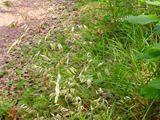Native Plants

Q. Who is Mr. Smarty Plants?
A: There are those who suspect Wildflower Center volunteers are the culpable and capable culprits. Yet, others think staff members play some, albeit small, role. You can torture us with your plant questions, but we will never reveal the Green Guru's secret identity.
Did you know you can access the Native Plant Information Network with your web-enabled smartphone?
Ask Mr. Smarty Plants is a free service provided by the staff and volunteers at the Lady Bird Johnson Wildflower Center.

rate this answer
Tuesday - February 03, 2009
From: Bowie, MD
Region: Mid-Atlantic
Topic: Erosion Control
Title: Native plants to prevent erosion in Maryland
Answered by: Barbara Medford
QUESTION:
Please can you recommend native plants for a north-facing slope, under pine trees? I live in Maryland near the border between the Coastal Plain and Piedmont Plateau, where we have cold to mild Winters and hot, humid Summers, but also frequently have drought conditions. I want to put in native plants to hold this north slope and prevent erosion under the pine trees, but want plants that don't require me watering them once they're established. Attractive/interesting bloom is not essential.ANSWER:
The best plants for your condition are native grasses, especially since you specified that interesting blooms was not an issue. Grasses have fibrous roots, and grab and hold the soil. They do it for selfish reasons, of course, so they will have dirt to live in and perpetuate themselves but you get the advantages also. You are probably already aware that it is difficult to grow much under pine trees, because of their heavy shade and the blanket of needles beneath them. They also, over time, will cause more acidity in the soil. So, we'll check for acid and shade tolerance of the grasses we choose as examples. To find these grasses, we'll go to our Native Plant Database, go down to COMBINATION SEARCH, select Maryland on the drop-down menu, then select "grasses" under Habit and shade to part shade on Light Requirements, then click on "Submit combination search." We will then follow the plant link to each plant's page and check on the acidity or alkalinity of the soil preferred by each grass. You can do the same thing, adding in such specifications as Soil Moisture. We are going to leave the Duration blank, so the database will select both annual and perennial grasses.
These plants, either as plugs or seeds, are all commercially available. If you have difficulty locating them, go to our Native Plant Suppliers section, type your town and state into the "Enter Search Location" box and you will get a list of native plant nurseries, seed suppliers and landscape and environmental consultants in your general area.
GRASSES/GRASS-LIKE PLANTS FOR MARYLAND
Andropogon gerardii (big bluestem) - perennial, 4 to 8 ft. tall, moderately acid and saline tolerant
Andropogon virginicus (broomsedge bluestem) - perennial, 2 to 5 ft. tall
Bouteloua curtipendula (sideoats grama) - perennial, 2 to 3 ft. tall
Bouteloua hirsuta (hairy grama) - perennial, 10 to 18 inches tall
Carex blanda (eastern woodland sedge) - perennial, 1 to 3 ft. tall
Carex texensis (Texas sedge) - perennial, 10 to 12 inches tall
Chasmanthium latifolium (Inland sea oats) - perennial, 2 to 4 ft. tall
Elymus canadensis (Canada wildrye) - cool-season perennial, 2 to 4 ft. tall
Melica nitens (threeflower melicgrass) - perennial, 3 to 5 ft. tall
Muhlenbergia schreberi (nimblewill) - perennial, 1 to 3 ft. tall
Schizachyrium scoparium (little bluestem) - perennial, 1 to 3 ft. tall
Tripsacum dactyloides (eastern gamagrass) - perennial, 2 to 3 ft. tall
More Erosion Control Questions
Plants to stabilize a steep bank in South Carolina
January 09, 2010 - I would like to use native plantings to stabilize a steep bank. The bank is on the side of the gravel road I cut back into the woods and around a 36" pipe going under the road to allow the free flow ...
view the full question and answer
Economical, low maintenance plants for erosion control on a bank
May 29, 2006 - Please advise of all species suitable for preventing bank erosion, specifically those that will cover a southern exposure 400 foot long, 15 foot high bank in western North Carolina that grows rapidly ...
view the full question and answer
Recommendations for a steep slope in Arlington, VA
September 10, 2015 - I have a side yard area about 35' long and 10' wide. It is very steep and get full sun. I recently I removed all the weeds down to dirt. I want to do low maintenance plants with mulch.
view the full question and answer
slope stabilization in Massachusetts
January 09, 2012 - My family and I recently put in a 120 x 100 horseback riding ring. It had to be built up in the back and, as a result, there is a 10 foot slope which could use stabilization. What plants native to Mas...
view the full question and answer
Plants to prevent erosion in IL
August 02, 2012 - We just got done building a house and have leveled all of the dirt piles. We do have a row of straw bales to help prevent the dirt from washing onto the neighbors property. It is the wrong time of ye...
view the full question and answer
| Support the Wildflower Center by Donating Online or Becoming a Member today. |

